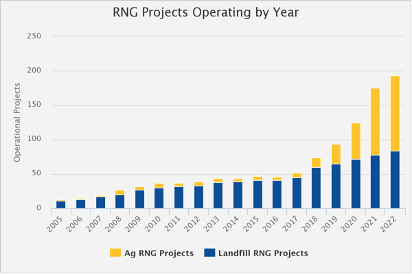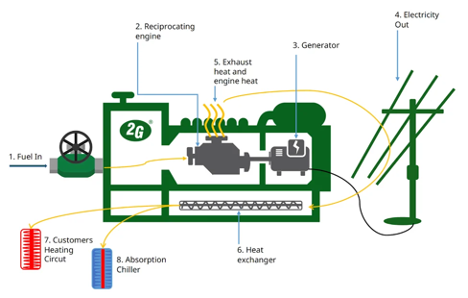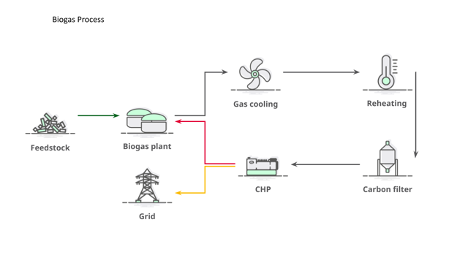Optimizing RNG's Carbon Intensity
Biogas Upcycling: Turning Organic Waste into Clean Energy
Upcycling biogas is an eco-friendly and sustainable process that transforms organic waste into valuable clean energy. This approach reduces the amount of waste that ends up in landfills or incinerators and promotes renewable energy production, lessening our dependence on fossil fuels.
Additionally, it has the potential to create new job opportunities and stimulate economic growth, especially in rural areas. Upcycling biogas provides a comprehensive and effective solution for waste management challenges while supporting sustainable energy production. As a leading provider of biogas treatment and CHP systems, 2G Energy North America offers a variety of CHP systems designed to enhance the potential of biogas, resulting in more efficient and sustainable practices.
Anaerobic Digestion to Biogas – Different Types of Biogases
Anaerobic digestion is a biological process wherein microorganisms decompose organic matter in an oxygen-deprived environment, producing biogas. This biogas comprises primarily methane and CO2. The methane component can be utilized as a valuable energy source for electricity or heat generation, while the carbon dioxide can be repurposed for applications like fertilizer production and other industrial processes. This efficient process of organic waste conversion into biogas holds significant promise for sustainable energy generation and waste management practices.
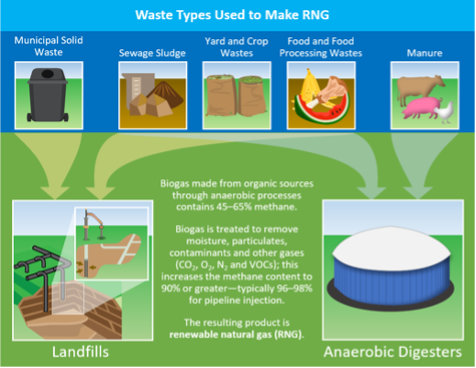
https://www.epa.gov/lmop/renewable-natural-gas
Within the biogas domain, various types of biogases exist, each possessing unique properties. One such example is Renewable Natural Gas (RNG). Renewable Natural Gas (RNG) can be used to power both residential and transportation sectors, and it has significantly lower greenhouse gas emissions than other fossil fuels. This makes RNG a more sustainable and environmentally friendly fuel choice.
https://www.epa.gov/lmop/renewable-natural-gas
One of the most significant benefits of RNG is its lower greenhouse gas emissions. When RNG is burned, it produces significantly fewer greenhouse gases than fossil fuels. This makes RNG a valuable tool for mitigating climate change and reducing our carbon footprint.
Another benefit of RNG is its seamless integration into existing infrastructure. RNG can be easily blended with natural gas and transported through existing pipelines. This makes it a cost-effective and efficient alternative to fossil fuels and facilitates widespread adoption.
Maximizing the Potential of Biogas
Utilizing Biogas in CHP - How it Works
Combined heat and power (CHP) systems are a promising solution for sustainable energy generation. CHP systems utilize biogas as a fuel to power either an engine or a turbine, driving the generation of electricity. The beauty of CHP lies in its dual functionality. Simultaneously, the heat produced as a byproduct of electricity generation is captured and employed for steam, other industrial processes, and cooling. This integrated approach enhances energy efficiency and reduces greenhouse gas emissions.
The utilization of biogas in CHP systems necessitates an understanding of its operational dynamics. Biogas is a renewable fuel source because it is produced from organic waste. Therefore, CHP systems can help to reduce energy waste, greenhouse gas emissions, and energy costs.
In summary, CHP systems are a promising solution for sustainable energy generation. They can help to reduce energy waste, greenhouse gas emissions, and energy costs. This makes them a valuable tool for decarbonizing the energy sector and mitigating climate change.
Creating RNG from Biogas
Renewable Natural Gas (RNG) is produced by upgrading conventional biogas. This process removes impurities, including carbon dioxide and other contaminants, to create a premium, low-carbon fuel. The purified RNG can be seamlessly introduced into the natural gas grid, opening doors to a wide array of applications that benefit from a cleaner and renewable energy source.
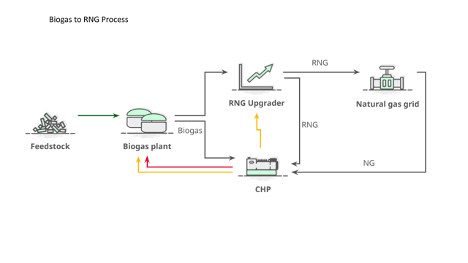
Overall, the production of RNG is a promising solution for sustainable energy generation. RNG has many benefits, including its low-carbon emissions, ability to be integrated into existing infrastructure, and its versatility as a fuel.
(View a Biogas Case Study: Stanton Farms)
The Carbon Intensity Impact of RNG from Fueling CHP with Biogas
Benefits of RNG - Incentives (IRA/ITC) and the Positive Impact on Greenhouse Gases
Renewable Natural Gas (RNG) offers a host of benefits that extend beyond its environmentally friendly nature. The Government also recognizes its potential to reduce greenhouse gas emissions and has incentivized RNG production and adoption. Economic benefits like the Investment Tax Credit (ITC) and the Inflation Reduction Act (IRA) encourage the growth of RNG projects, fostering a positive impact on our efforts to combat climate change.
To learn more about the IRA/ITC incentives, check out our blog: An Explanation of the Investment Tax Credit (ITC) and the Role of CHP.
Calculate the Impact on CI Score and Price of RNG Produced by Your Anaerobic Digester
Carbon intensity (CI) scores are a crucial component of California's Low Carbon Fuel Standard (LCFS), a regulatory framework aimed at reducing greenhouse gas emissions in the transportation sector. CI scores quantify the amount of carbon dioxide equivalent emitted per unit of energy produced, and fuels with lower CI scores are considered cleaner and more environmentally friendly.
The California Air Resources Board (CARB) annually establishes a carbon intensity benchmark that serves as a reference point for all fuels used within the state. Fuels with CI scores below the benchmark are eligible to earn LCFS credits, which can be sold or used to offset emissions from other sources. This incentive structure encourages the adoption of low-carbon and renewable fuels and helps to achieve the state's ambitious climate goals.
In summary, CI scores play a crucial role in the LCFS by providing a framework for comparing the environmental impact of different fuels. This proactive approach aids in achieving the state's ambitious climate goals, ultimately contributing to a cleaner and more sustainable transportation sector.
2G Energy North America's engineering team offers valuable insights and calculations. Embracing biogas upcycling with RNG and CHP systems supports waste management solutions and builds a greener and more sustainable world.
If you would like our engineering team to calculate the impact on the CI score and price of RNG produced by your anaerobic digester, please contact us by following the link below.
Key takeaways:
- Biogas upcycling is a sustainable and eco-friendly process of converting organic waste into valuable clean energy. Utilizing biogas through anaerobic digestion reduces landfill waste and promotes renewable energy generation, lessening our reliance on fossil fuels.
- Renewable Natural Gas (RNG), an exemplary biogas type, offers lower greenhouse gas emissions, seamless integration into existing infrastructure, and versatile applications in residential and transportation sectors.
- Combined heat and power (CHP) systems further optimize biogas potential by generating electricity while capturing and utilizing valuable heat, enhancing energy efficiency, and reducing waste.
Understanding carbon intensity (CI) scores in the Low Carbon Fuel Standard (LCFS) incentivizes cleaner fuels like RNG, driving progress towards a cleaner, more sustainable energy future. Embracing biogas upcycling with RNG and CHP systems contributes to waste management solutions, supports renewable energy adoption, and advances our commitment to combat climate change and create a greener tomorrow.

